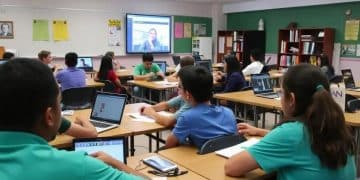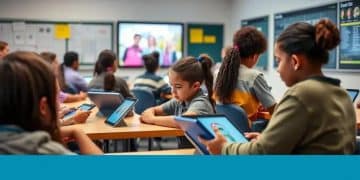Insights on vr learning environments: Transforming education
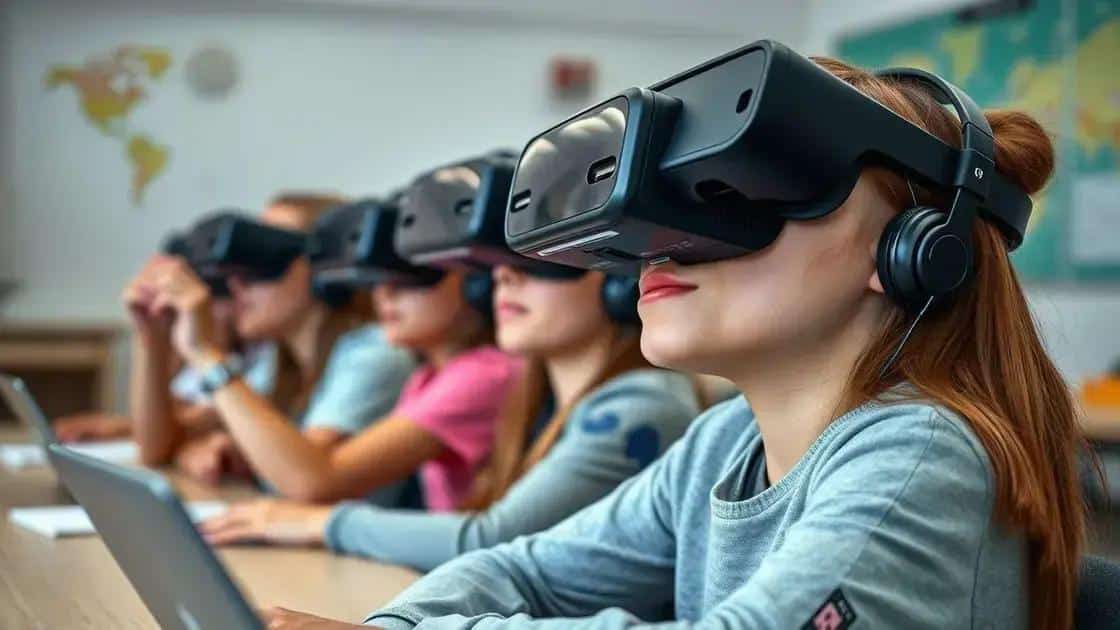
Insights on VR learning environments reveal that immersive technology enhances student engagement and understanding while providing opportunities for personalized and interactive educational experiences.
Insights on VR learning environments reveal how these innovative setups can captivate students and enrich the learning experience. Have you ever wondered how technology can transform traditional education into engaging, interactive adventures? Let’s dive in!
Understanding virtual reality in education
Understanding virtual reality in education helps clarify how this technology can transform classrooms into engaging learning spaces. With VR, students can explore new worlds and concepts in ways that textbooks cannot offer. Imagine taking a virtual field trip to the pyramids of Egypt right from your classroom!
One of the key benefits of VR in education is its ability to enhance immersion. When learners experience a subject matter in a virtual environment, they can interact with it in a meaningful way. This kind of hands-on learning helps maintain student interest and retention of information.
How VR Works in Learning
VR technology uses headsets to create immersive environments. Students wear these headsets to dive deep into subjects like science, history, and art. Here’s what makes it special:
- Interactivity: Students can engage with virtual objects and scenarios.
- Realism: Environments replicate real-life settings accurately.
- Accessibility: VR provides experiences that may be impossible or unsafe to recreate in real life.
Integrating VR into the classroom is not just about fun; it improves educational outcomes. Teachers can tailor lessons that align with specific learning objectives while keeping students engaged. For instance, anatomy lessons become interactive as students explore the human body up close.
Challenges of VR Implementation
Despite its advantages, implementing VR in education can come with challenges. Many schools face budget constraints, limiting their ability to acquire necessary equipment. Additionally, teacher training is crucial to effectively use this technology.
Some educators worry about screen time and its impact on students. However, when used wisely, VR can complement traditional teaching methods, enhancing the overall learning experience. It’s vital to balance VR experiences with other learning activities to ensure comprehensive education.
As we explore more about VR in education, it’s clear that its potential is just beginning to be tapped. The more we understand how to utilize this technology, the better we can equip our students for future challenges.
Benefits of VR for immersive learning
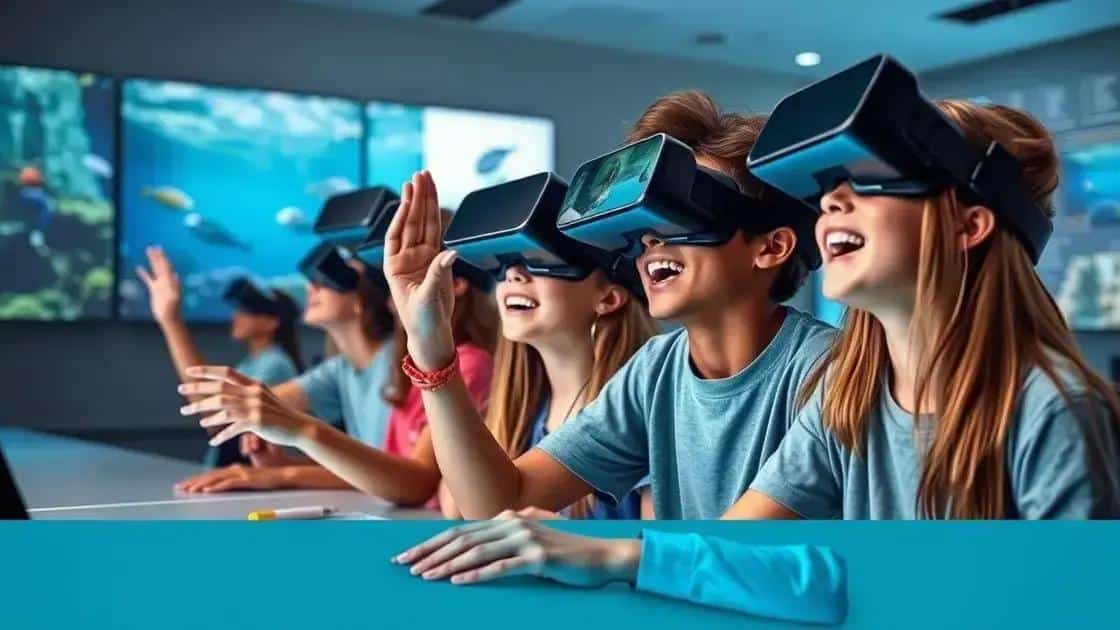
Benefits of VR for immersive learning are becoming increasingly clear as educational institutions explore this innovative technology. One major advantage is the ability for students to experience real-world scenarios without leaving the classroom. For example, learning about marine biology becomes exciting when students can dive underwater in a virtual ocean.
Additionally, VR encourages active participation. Instead of passively reading or watching lectures, students are immersed in their lessons. They can interact with the environment and make decisions that affect their learning experience. This interaction keeps them engaged and interested.
Enhanced Understanding
VR also offers a unique way to explain complex subjects. When students can visualize topics like geometry or historical events, their understanding deepens. They can explore three-dimensional shapes or walk through ancient cities, making abstract concepts more tangible.
- Visual Learning: Students remember information better when they see and interact with it.
- Cultural Awareness: Virtual trips allow students to learn about different cultures without traveling.
- Real-life Skills: VR can simulate real-world tasks, helping students gain practical experience.
Another notable benefit is the ability to provide personalized learning experiences. With VR, teachers can tailor lessons to the individual needs of their students. If a student struggles with a concept, VR can offer additional resources and opportunities for practice.
Boosting Confidence
Using VR can also boost student confidence. Engaging in simulations allows them to practice public speaking or complex problem-solving in a safe environment. By experimenting without the fear of failure, students build self-esteem and readiness for real-life challenges.
Moreover, VR can facilitate collaboration among students. Groups can work together in virtual spaces, encouraging teamwork and communication. This aspect is crucial for developing valuable skills that they will need in their future careers.
Overall, the benefits of VR for immersive learning extend far beyond traditional methods. With endless possibilities, educators can cultivate a rich learning environment that not only captures attention but also enhances understanding and skill acquisition.
Challenges of implementing VR learning environments
Challenges of implementing VR learning environments can be significant, but understanding them is crucial for successful integration in education. One major challenge is the cost of acquiring VR technology. Schools may struggle with budget limitations, making it difficult to obtain multiple headsets and necessary equipment.
Besides the financial aspect, teacher training is essential for maximizing the benefits of VR. Many educators may feel unprepared to use this technology effectively. Professional development programs are vital to equip teachers with the skills they need to teach with VR.
Technical Limitations
Another challenge relates to the technical aspects of VR. Not all classrooms have the required infrastructure, such as high-speed internet and sufficient hardware. If the technology fails, it can cause frustration for both students and teachers.
- Compatibility Issues: Not all VR software works on every device, which can complicate implementation.
- Technical Support: Schools may need ongoing technical support to troubleshoot VR systems.
- Device Maintenance: Regular maintenance is necessary to keep the equipment in good condition.
Furthermore, there is a concern about student screen time. With the growing use of technology in education, parents and educators worry about the potential negative impacts on health. Balancing VR with traditional learning is important to ensure students maintain a healthy relationship with technology.
Adaptation and Acceptance
Adapting to this new form of learning can also be a challenge. Not all students respond the same way to VR experiences. Some may find it intimidating or overwhelming. Additionally, educators must consider how to engage all students, ensuring that no one feels left out.
Moreover, there is a gradual acceptance of VR technology within educational institutions. Some schools may hesitate to adopt VR due to misconceptions about its effectiveness or suitability for certain age groups. Proper studies and pilot programs can help demonstrate its value.
Overall, while the challenges of implementing VR in learning environments can be daunting, addressing them strategically will pave the way for innovative educational experiences.
Future trends in VR educational technology
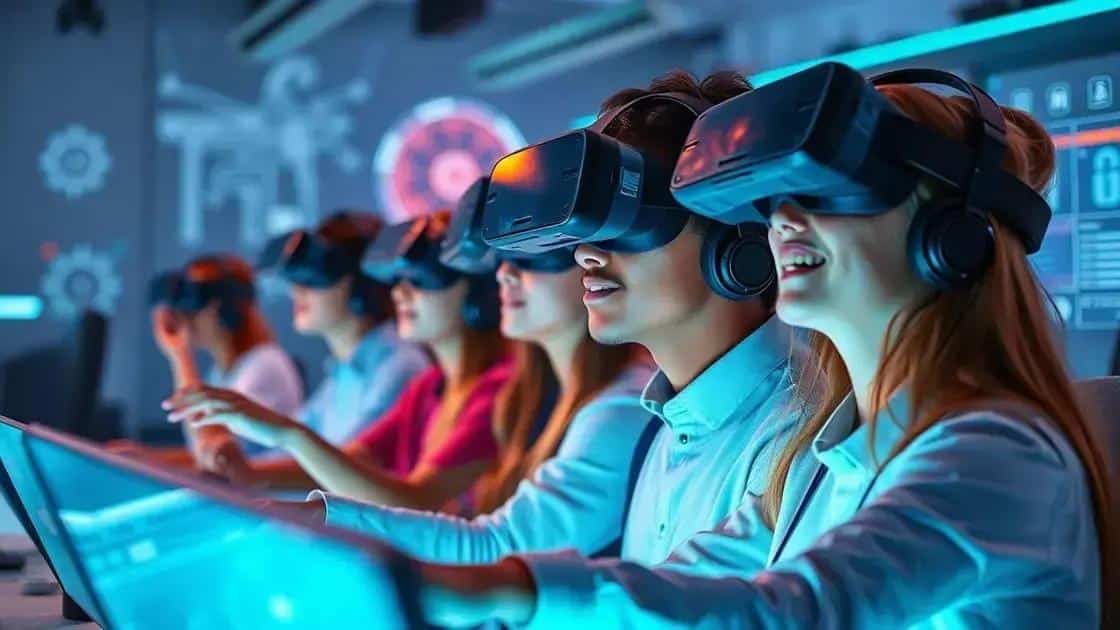
Future trends in VR educational technology are paving the way for exciting advancements in how we teach and learn. As technology continues to evolve, Virtual Reality (VR) holds immense potential for transforming educational experiences. Students may soon find themselves navigating immersive landscapes that mimic real-world environments and situations.
One promising trend is the development of more affordable VR solutions. As competition increases in the tech market, prices are likely to decrease, allowing more schools to invest in VR technology. This democratization of technology can lead to wider adoption in classrooms across various educational levels.
Enhanced Interactivity
Another key trend is the push for enhanced interactivity within VR environments. Expect more platforms to integrate gamification elements into learning experiences. This will make lessons not only educational but also engaging and enjoyable for students. They can earn rewards, complete challenges, and work collaboratively in virtual spaces.
- Customizable Learning Paths: Students may have the ability to choose their learning adventures, allowing them to focus on areas that interest them most.
- Real-Time Feedback: Immediate insights into student performance will be possible, helping teachers tailor their instruction.
- Collaborative Learning: Virtual classrooms will enable peer interaction even from miles away, reinforcing social skills and teamwork.
In addition to enhancing interactivity, ongoing advancements in technology will provide more realistic simulations. Students will not only see but also experience complex scenarios in fields like medicine, engineering, and environmental science. Training future doctors, for instance, could involve practicing surgeries in a lifelike virtual operating room.
AI Integration
The integration of artificial intelligence (AI) with VR is another trend to watch. AI can help personalize learning experiences based on each student’s progress and learning style. Imagine a virtual tutor that adjusts its teaching approach dynamically, ensuring that each student receives the help they need.
Additionally, the growing use of augmented reality (AR) alongside VR can create hybrid learning environments that offer even more depth. Such environments augment the physical space with digital information that complements VR lessons.
As we look ahead, it’s evident that the future of VR in education holds promise. By harnessing these trends, educators can create more enriching and effective learning environments for students worldwide.
FAQ – Frequently Asked Questions about VR in Education
What are the main benefits of using VR in education?
VR provides immersive learning experiences, enhances engagement, and allows for interactive learning that can improve understanding of complex subjects.
What challenges do schools face when implementing VR technology?
Schools often struggle with costs, teacher training, and the need for adequate technical infrastructure to support VR.
How can AI be integrated with VR in educational settings?
AI can personalize learning experiences by adapting content and feedback based on students’ individual progress and learning styles.
What future trends can we expect in VR education?
Future trends include more affordable VR solutions, enhanced interactivity, and increased AI integration for personalized learning environments.




